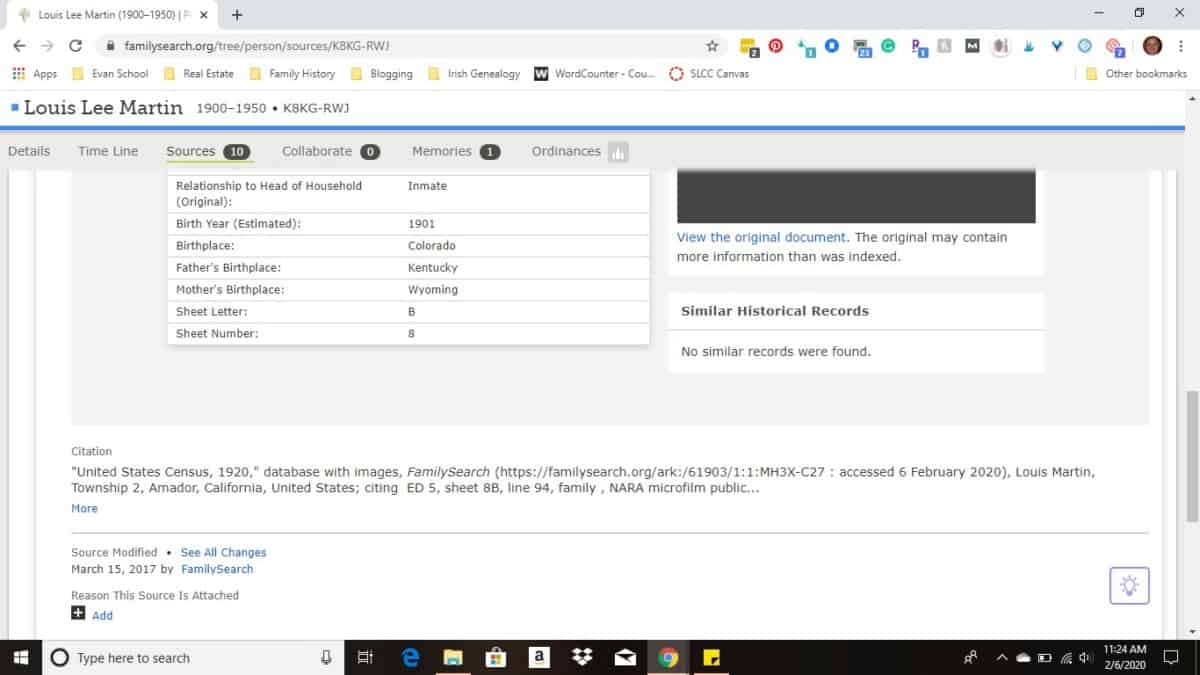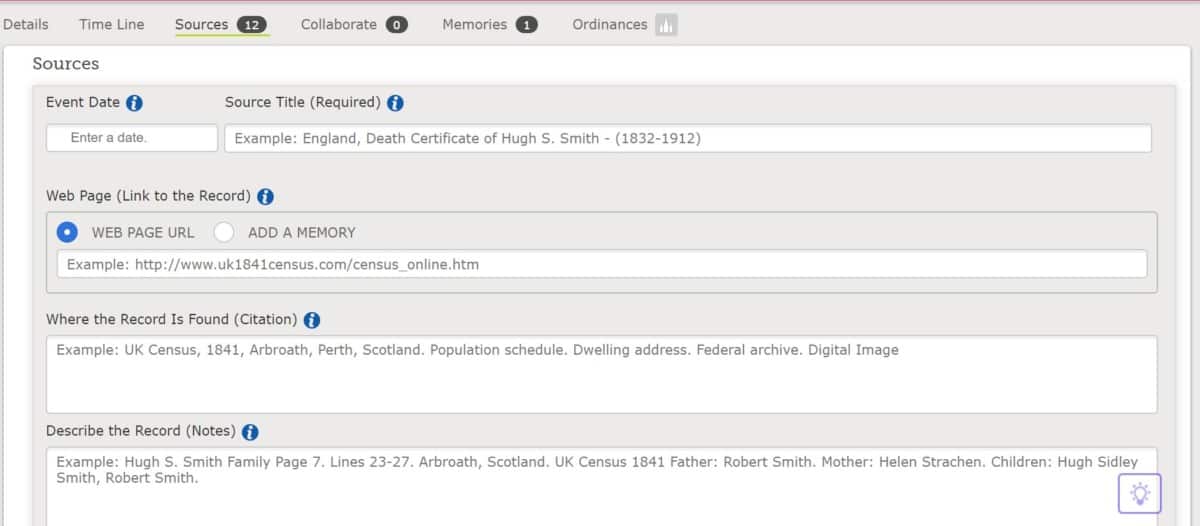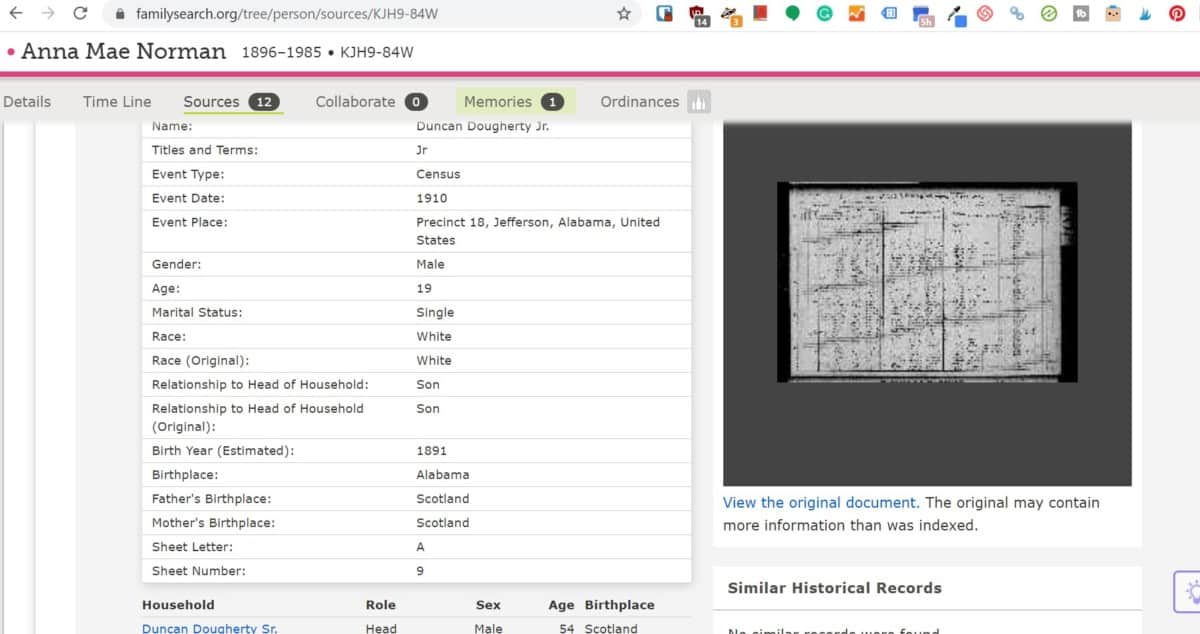When you’re first starting out, genealogy is such a big topic that it’s really easy to feel overwhelmed. We remember feeling that way at first, too! So how do you start doing genealogy – without getting so overwhelmed you want to quit?
To start doing genealogy:
- Identify a single question or a research goal.
- Write down what you already know about the answer or goal.
- Identify known and potential sources for your research.
- Find your answers and cite new sources found along the way.
- Analyze the results to see if you’ve found your answer or reached your goal.
- Start again with a new goal or question in mind.
Because when you’re just trying to find one little answer, suddenly genealogy isn’t overwhelming – it’s a mystery that you’re bound and determined to solve. Keep reading and let’s dig into each of these steps further together!

How to Start Doing Genealogy
Look, the question of how to start doing genealogy is a good one. It’s one we both asked when we first started out. It’s one I need to review regularly after taking even a short break from doing genealogy, too. So don’t feel bad asking it. Genealogy is a big topic and it’s easy to feel overwhelmed.
So let’s look at our six simple steps on how to start doing genealogy – along with an example so that it’s super clear.
| How to Start Doing Genealogy Steps | Notes and Examples |
|---|---|
| 1. Identify a single question or a research goal. | I want to find my great-grandparents’ marriage information: date, location, and maiden names. |
| 2. Write down what you already know. | I know both great-grandparents’ first names, paternal surnames, and the approximate year of the marriage. Not sure of the location. |
| 3. Identify known and potential sources. | I’ll use censuses to narrow my family’s known location, then search the appropriate state archives for marriage certificates. |
| 4. Find your answers and cite new sources found. | Thanks to a newly-released census, I found that I’d been searching the wrong states for the marriage certificate! |
| 5. Analyze the results. | Thanks to the census, I was able to locate the right state. I also found that my great-grandparents had another son, who died as an infant, that needed to be added to that family group record. |
| 6. Start again with a new goal or question. | Now I want to find sources detailing my great-grandmother’s family information. |
See how much easier it is, once you’ve narrowed things down to a single question or goal? SO. MUCH. EASIER.
Oh, and our example? That was my research question several years back. There had been a brick wall after those great-grandparents – we were struggling to find any sources or certificates for that family line. The census information let us know we’d simply been looking in the wrong state – and helped me find my previously-unknown Great-Uncle Bobby.
Now that we’ve given a cool example, let’s talk about each step in even more detail. That way, you’ll be totally ready to start doing genealogy and won’t let anything stop you!
Set a Genealogy Research Goal
Odds are you’ve already got a research goal in mind. Your goal can simply be a question or a thought that’s been on your mind. When you work on a single question (or goal) at a time, you’re going to be able to enjoy doing genealogy more – and be far less overwhelmed.
Even so, take some time to really think about your question. Think about what it is you want to accomplish.
- Maybe you’re looking to verify if a juicy story or piece of family lore is really true.
- Perhaps you’re looking for a biological parent or family member to answer your deepest questions.
- Maybe you want to find a living family member with whom to talk about genealogy.
- Or maybe you’re a member of the Church of Jesus Christ who wants to take family names to the temple.
- Or perhaps you have a different burning question on your mind.
These are all fantastic research goals and questions! And it’s yours, so you’re going to want to find the answer. Just remember that it can be really easy to get distracted doing genealogy, so commit to staying focused. Most importantly, write down your specific research questions and goals.
Be sure to write down your research goals. Otherwise, you’ll start out looking for your maternal grandma’s birth certificate and the next thing you know you’re trying to find more information about your paternal great grandpa’s military service. Or worse, you’ll completely forget what you started looking for. It happens to all of us – unless we take a moment to write down our questions and goals.
Breanne
Depending on your personal faith and beliefs, you may also want to be prayerful as you consider your genealogy goals and research questions. As members of the Church of Jesus Christ, we believe that praying about genealogy can unlock heavenly help and inspiration.
So if you’re struggling to decide on a goal or research question, take a few moments to pray and meditate. Then, as you receive inspiration and guidance, write that down, too.
A quick warning, before we continue into the next step, though. As you get into the research steps, you are going to find other questions. It’s tempting to follow those questions further down the rabbit hole. But it will come at the expense of finding answers to your original question. And that path leads to a place where you’ll quickly feel overwhelmed, lost, and like quitting.
So instead of chasing genealogy rabbits, recognize when you find new questions and research options. Write those questions and ideas down. Consider it a running genealogy to-do and research list.
Need a to-do list so you can avoid falling down those genealogy research rabbit holes? We’ve got a free solution for you. Subscribe to our free newsletter – and we’ll give you access to our whole library of cool worksheets and forms – including the Genealogy To-Do List. You can subscribe at the bottom of this article.
That way, you won’t ever be afraid that you’ll forget someone or a question. And as an added bonus, when family members ask you what genealogy work they can do, you’ll be able to give them specific research tasks that help them enjoy doing genealogy while furthering your research.
Make a List of What You Already Know
Now that you know your question, it’s time to think about (and list) everything you already know about that topic. This can be dates, names, stories, family lore, or whatever else. Just write it all down.
This step may mix with and into the next one, where you’ll identify known and potential sources. This is especially the case if you have to use your existing sources to help you remember what you do (or don’t) know about your question. If so, that’s just fine. I have to reference my sources regularly, too.
Remember my example? I knew my great-grandparents’ first names off of the top of my head. Okay, I also knew my great-grandfather’s last name, because it’s my mom’s maiden name. But I couldn’t recall middle names, dates, or important locations without some help. So I logged into my account on FamilySearch.org and looked them up really quickly.
But that’s getting us into the next step, so let’s go ahead and go there now.
Identify Known and Potential Sources
Now that you have your question and have determined what you do know, it’s time to make sure you aren’t reinventing the proverbial family history wheel. Nobody I’ve ever met wants to spend hours doing research – only to find out that it’s already been done and has all the proper citations. That’s a sure-fire road to feeling deflated and undervalued.
So first, think back on what you do know – this is what you figured out in the previous step. Now, let’s brainstorm some more existing and potential sources to verify what we do know – and to help us find our answers without doing extra work.
An important part of this step is to find out what information sources are already out there and available to you.
What is a source? It’s where you get your information: a census record, a birth/marriage/death/christening certificate, deeds, transactions, or other public record documents. How you record that source, so others can look it up, is via a citation. Most genealogy sites help you create citations for your sources via a fill-in-the-blank form.
Here’s an example of a source and a citation from FamilySearch.org.

Here are the most important sources to reference as you’re starting out:
- Talk to family members and see what has already been done on your research question.
- Look at your existing family tree, family documents, or existing accounts on your favorite genealogy website.
- Log onto FamilySearch.org (it’s free for everyone) and do a quick search of millions of records or connect to countless shared family trees.
- Log onto Ancestry.com’s public member trees and search for your family information with those.
Be sure to write down your source citations for the future. That way, you (and others) will know where your information came from. Your genealogy website of choice should help you create a standardized citation for each and every source – and even append (or attach it) to the event so it’s easier to follow the research trail.
I like to keep my citations and list of sources right on FamilySearch.org. Each image or document I upload lets me fill in the citation information for the source, which makes it super easy. There’s also a way to look up the sources and citations of people on your tree – whether you added them or others did. It’s really neat to be able to see your family’s paper trail grow over time!
A quick warning about using public and shared member trees – some can be problematic and/or contain false information. This is especially the case if there are no listed citations on the source. So check any shared or public trees for listed sources and documents before you squeal in delight at having found something. Then write down and verify that paper trail documentation before importing it to your own family tree.
Once you’ve identified what you do know, it’ll help you see where the gaps are. Next, it’s time to fill those gaps and find sources.
Find Answers and Cite New Sources
Now that we’ve avoided doing extra work (that’s already been done), it’s time to find new sources that will help us find our answer. Just remember -we’re going to be saving and citing those newly-discovered sources along the way.
That way, we’ll have a paper trail of proof to show that our findings are, in fact, valid. Plus, this is just good genealogy practice. Anyone who thinks they’ll be able to always remember where and when they found that specific newspaper clipping is, as I’ve discovered from painful experience, quite delusional. Write down the source – or you’ll have to go find it again anyway!
What is a citation? Citations are how you document where your information came from (remember all those high school essays?). There is an official citation manual for genealogists that professionals use. However, there is also a prompt system on most genealogy websites that will guide you through that process. This prompt system works great for most beginners and intermediate-level genealogists.
So as you’re starting to do your genealogy, make sure that you’re writing down and citing your sources. That way, you’ve got access to the information and those you’re collaborating with will also have that information.

Here’s a quick genealogy PSA from Breanne:
Please do your genealogy responsibly! Don’t spread information that doesn’t have a good source attached to it. It’s beyond frustrating when you find a piece of information you’ve been searching for – information that could help you past a brick wall in your research. Only then you find there is no citation and that the brick wall is still very much still in place.
Breanne
The sources that will help you most will depend on the information and answers you’re researching. Even so, one of the most popular sources for all genealogists is census records. They’re easy to search, give you a lot of information quickly within a single record, and are quickly becoming digitized thanks to indexing efforts.

So when in doubt, start looking in a census record. That should give you a lot of good information and ideas about where to search next. Just remember to cite that census record in your sources!
Find New Relatives as Sources
Before we move on to analyzing our results, let’s take a moment to discuss an important new source to always keep an eye out for – new relatives.
As you’re climbing in that family tree of yours, you’re going to find new branches you didn’t know about. And hopefully, some of those branches will lead you to living relatives. Consider connecting with them so that you can compare notes on your genealogy.
You aren’t limited to just calling family members you know or family members you find via DNA matches. Look through public family trees that have strong similarities with yours and reach out to their creators. FamilySearch.org, for example, shows you a tree contributor’s screen name – along with an option to see any potential relationships to that person. Use that screen name in FamilySearch’s system to reach out to that potential cousin – and talk to them, too!
Breanne
Your new-found cousins may have the answers you’ve been looking for. So consider using your genealogy (or even a DNA/genealogy test – click here to see the best ones we’ve found for matches) to find living sources. And yes, you can totally cite your cousins as sources! 🙂
Analyze Your Results
Now that you’ve found (and cited) your sources, it’s time to analyze your results. Make sure you’re mining those sources for every possible bit of information possible! Those tidbits of information will help you keep going with further research in the future.
Then, ask yourself how things went. You may also want to ask these questions.
- Did my genealogy research give me the answer we expected or hoped for? Why or why not?
- Did my genealogy research give me an answer, even if it wasn’t the ideal answer?
In some cases, your initial research may not yield any results. That’s okay. That happens. That doesn’t mean you won’t ever find an answer – it just means you haven’t found it yet. You’ll get to decide if you’re going to keep looking – whether that means immediately or temporarily shelving this question for a few weeks (or months) while you work on another question.
Keep a log of where you have looked so far. That way, you won’t keep looking at the same sources and get frustrated wondering why you can’t find your answers. Instead, you can guide future searches towards different and potentially more fruitful sources. If you don’t have a log, download one of ours from our resource library – a free and exclusive bonus for our newsletter subscribers.
Breanne
In other cases, your research may help you discover the exact answer you were looking for. That answer may (or may not) be what you were expecting.
In my case, my research helped me find where my great-grandparents were located – and it was not where I was expecting to find them! However, I did find them and a new Great-Uncle who’s since been added to the family tree. My analysis showed that I did find my answer – and it made me even more excited to keep finding information on that line!
And speaking of wanting to keep finding information, it’s time to restart the whole process.
Start Again and Do More Genealogy Research
Now that you’ve done your analysis, it’s time to decide to keep going with your genealogy. You might:
- Decide that your first question wasn’t answered satisfactorily enough – and so you’re going to restart the genealogical research process and search for these answers again in different sources.
- Decide that your question was answered – and now you have a list of 12 more to work your way through!
Either way is totally fine. Because now you know how to start doing genealogy – and how to find answers to your deepest, most pressing genealogy questions. And you will, over time, find answers. Even the ones that you had to shelf for a little while.
Every day there are more and more sources becoming available online – which is making online genealogy work more accessible and easy to do for everyone. You can do this – you can start doing genealogy and find the answers to your questions.
Congratulations – and welcome to being a genealogist pal!
Related Questions
How Can I Research My Genealogy For Free? Free genealogy websites help individuals track their genealogy. The best free genealogy website is FamilySearch.org. For more information on the best genealogy websites (including free ones), read our article on the best genealogy websites here.
How Do You Write a Genealogy? Genealogy is the study of ancestry and family lines. Writing a genealogy can mean tracing lines and/or keeping a record of family stories by journaling.
Where Can I Learn More about Being a Genealogist? Genealogists are those who study family history in or separate from the context of world history. To learn more about who studies genealogy (and why they do) click here.
Get Genealogy and Family History News and Tips in Your Inbox.
Any time there’s a cool update to the world of genealogy, you’ll get an email with our explanation of it – and information on how you can implement the latest and greatest evidence-based research and practices in your family history. We only send emails a few times a year.
It’s free to get cool stories, updates, news, and more. Subscribers get exclusive access to cool extras and downloadable files via the subscriber-exclusive library.
Join the Genealogy Pals newsletter community!
We use SendFox as our email marketing platform. By clicking to submit this form, you acknowledge that the information you provided will be transferred to SendFox for processing per their terms of use.
Want a sneak peek at some of what’s in the subscriber-exclusive library? Check it out here.
